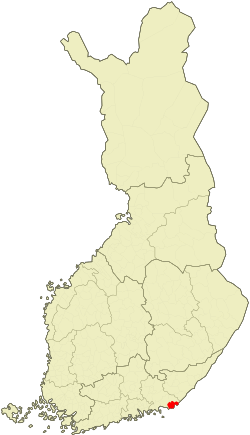Virolahti
Virolahti (Swedish: Vederlax) is the southeastern-most municipality of Finland on the border of Russia. It is located in the Kymenlaakso region. The municipality has a population of 3,148 (31 January 2019)[2] and covers an area of 558.92 square kilometres (215.80 sq mi), of which 186.97 km2 (72.19 sq mi) is water.[1] The population density is 8.46 inhabitants per square kilometre (21.9/sq mi).
Virolahti Vederlax | |
|---|---|
Municipality | |
| Virolahden kunta Vederlax kommun | |
 Coat of arms | |
 Location of Virolahti in Finland | |
| Coordinates: 60°35′N 027°42′E | |
| Country | |
| Region | Kymenlaakso |
| Sub-region | Kotka–Hamina sub-region |
| Government | |
| • Municipality manager | Marjatta Pahkala |
| Area (2018-01-01)[1] | |
| • Total | 558.92 km2 (215.80 sq mi) |
| • Land | 371.95 km2 (143.61 sq mi) |
| • Water | 186.97 km2 (72.19 sq mi) |
| Area rank | 208th largest in Finland |
| Population (2019-01-31)[2] | |
| • Total | 3,148 |
| • Rank | 217th largest in Finland |
| • Density | 8.46/km2 (21.9/sq mi) |
| Population by native language | |
| • Finnish | 95.3% (official) |
| • Swedish | 0.5% |
| • Others | 4.2% |
| Population by age | |
| • 0 to 14 | 14.3% |
| • 15 to 64 | 62.4% |
| • 65 or older | 23.4% |
| Time zone | UTC+02:00 (EET) |
| • Summer (DST) | UTC+03:00 (EEST) |
| Municipal tax rate[5] | 20% |
| Climate | Dfb |
| Website | www.virolahti.fi |
The municipality is unilingually Finnish.
Before World War I the Russian Emperor Nicholas II used to spend summers with his family in the archipelago of Virolahti with his yacht Standart, Finland being an autonomous province within the Russian Empire between 1809 and 1917.
The Vaalimaa border crossing, which connects the municipality with Russia, is located in Virolahti.
Virolahti lost some of its area (over 100 km2 (39 sq mi)) to Soviet Union in Paris Peace Treaties, 1947 after World War II.
Villages in 1939
Villages marked with an asterisk (*) are now completely or partially on the Russian side:
Alapihlaja, Alaurpala*, Eerikkälä, Hailila, Hanski, Hellä (Heligby), Hämeenkylä (Tavastby), Häppilä, Järvenkylä, Kattilainen, Kiiskilahti* (now Kiyskinlakhti), Kirkonkylä, Klamila, Koivuniemi, Koskela*, Koskelanjoki, Kotola, Kurkela, Laitsalmi*, Länsikylä (Flonckarböle), Martinsaari* (Now Island of Maly Pogranichny), Mattila, Mustamaa, Nopala, Orslahti* (now Primorskoye), Paatio* (Båtö in Swedish, now Bolshoy Pogranitshny), Pajulahti, Pajusaari*, Pitkäpaasi* (Island of Gorniya Kamenya), Pyterlahti, Ravijoki, Ravijärvi, Reinikkala, Rännänen (Grennäs), Sydänkylä (Kallfjärd), Säkäjärvi, Tiilikkala, Vaalimaa (Vaderma), Vilkkilä, Virojoki, Yläpihlaja, Yläurpala* (now Torfjanovka).
Notable people born in Virolahti
- Uuno Klami, composer
- Johannes Takanen, sculptor
- Aarne Sihvo, general
References
- "Area of Finnish Municipalities 1.1.2018" (PDF). National Land Survey of Finland. Retrieved 30 January 2018.
- "Suomen virallinen tilasto (SVT): Väestön ennakkotilasto [verkkojulkaisu]. Tammikuu 2019" (in Finnish). Statistics Finland. Retrieved 15 March 2019.
- "Population according to language and the number of foreigners and land area km2 by area as of 31 December 2008". Statistics Finland's PX-Web databases. Statistics Finland. Retrieved 29 March 2009.
- "Population according to age and gender by area as of 31 December 2008". Statistics Finland's PX-Web databases. Statistics Finland. Retrieved 28 April 2009.
- "List of municipal and parish tax rates in 2011". Tax Administration of Finland. 29 November 2010. Retrieved 13 March 2011.
External links
![]()
- Municipality of Virolahti – Official website (in Finnish)
- Map of Virolahti
